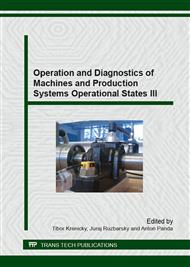[1]
C. Lange, T. Hungerkamp, Coinjection of thermoplastics and elastomers, Kunststoffe Plast Europe 91/12 (2001) 36-42.
Google Scholar
[2]
Z. Murcinkova, T. Krenicky, Applications utilizing the damping of composite microstructures for mechanisms of production machines and manipulator devices, in: Proc. 13th International Multidisciplinary Scientific Geoconference and EXPO SGEM 2013, Albena, Bulgaria, 16-22 June 2013, STEF92 Technology, Sofia, 2013, pp.23-30.
DOI: 10.5593/sgem2013/bf6/s24.004
Google Scholar
[3]
T. Werner, M. Fehlings, Thermoplastic elastomers (TPE), Kunststoffe Plast Europe 92/10 (2002) 38-40.
Google Scholar
[4]
A. Islam, H.N. Hansen, M. Marhofer, M. Bondo, A new pair of hard-soft plastic combination for precision manufacturing of two component plastic parts, in: Proc. of the 11th International Conference of the European Society for Precision Engineering & Nanotechnology, 23rd May-27th May 2011, Lake Como, Italy, Vol. 2, 2011, pp.184-187.
Google Scholar
[5]
F. Matysiak, Untersuchung zur Haftung von Flüssingsilikonkautschuk auf technischen Thermoplasten im 2-K-Verbundspritzgießen, Thesis, IKV, RWTH Aachen, (1998).
Google Scholar
[6]
A.L.R. Pires, A.M. Moraes, Improvement of the mechanical properties of chitosan-alginate wound dressings containing silver through the addition of a biocompatible silicone rubber, Journal of Applied Polymer Science 132/12 (2015), Art. No. 41686.
DOI: 10.1002/app.41686
Google Scholar
[7]
C. Chen, X. Wang, Z. Jia, T. Li, H. Lu, X. Zeng, R. Li, A polymer crystallization based study on the degradation mechanism of liquid silicone rubber, Proceedings of the Chinese Society of Electrical Engineering 34/9 (2014) 1462-1470.
Google Scholar
[8]
F. Wang, Y. Li, D. Wang, Adhesion enhancement for liquid silicone rubber and different surface by organosilane and Pt catalyst at room temperature, Bulletin of Materials Science 36/6 (2013) 1013–1017.
DOI: 10.1007/s12034-013-0575-8
Google Scholar
[9]
R. Ziebell, R.D. Abbott, C. Windiate, D. Corning, Improvements in a new generation of liquid silicone rubber. Rubber World 250/3 (2014) 22-32.
Google Scholar
[10]
M. Bortenschlager, Liquid silicone rubber, Wacker silicone, (2014).
Google Scholar


